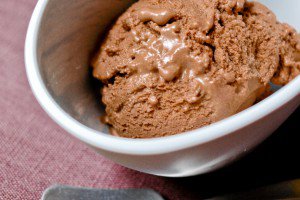La sorbetière (ice cream maker) is up there with la yaourtière (yogurt maker) in the list of appliances that were hot Mother’s Day gifts in the seventies but ended up in said mother’s attic pronto.
And yet, when Maxence came home with my birthday present and it was a bulky box hiding a spaceship of a sorbetière, I could not have been happier: first of all, he got the idea from a conversation we had weeks ago during which I wasn’t even dropping hints — no, really — and this is the best sort of gift in my book.
David’s recipe involves mangoes, lime juice, and dark rum; I took the liberty of adding the zest of the lime, and may replace that with a bit of grated ginger next time.
Secondly, I always feel sheepish about filling the apartment with bakeware and utensils and all sorts of bowls and plates — although he matches me cubic inch for cubic inch with vintage computers and robots and video game consoles — yet there he was, not just condoning my acquiring a new appliance, but actually buying it for me. Lastly, and more to the point: an ice cream maker! for me! an ice cream maker for me to make my own ice cream!
To demonstrate the extent of my gratitude, I asked the gift-bearer to choose what we should prepare first and he said, as I knew he would, “Un sorbet mangue.”
Delighted to finally be able to use it, I opened my friend David Lebovitz‘s beauteous ice cream book, The Perfect Scoop, looked up his recipe for mango sorbet, and got to work.
The only difficult part to sorbet-making, I’m finding out, is to have the patience to wait until the bowl is cold enough*. After that, it’s just a bit of whizzing and churning, and voilà! In under thirty minutes, we got our creamy-cool, rich and smooth mango sorbet — precisely what was needed on this sweltering Sunday afternoon.
David’s recipe involves mangoes (that’s a surprise), lime juice (the ideal flavor booster for mango), and dark rum (alcohol improves the texture of sorbets); I took the liberty of adding the zest of the lime, since I was using an organic one, and next time I may replace that with a bit of grated ginger. This sorbet would make a fine ice cream sandwich, too, squooshed between two very ginger cookies.
~~~
* Most home-use ice cream makers require that you place the bowl in the freezer 24 hours in advance, so that the walls of the bowl, which are filled with a sort of liquid ice, accumulate enough cold to lower the temperature of your preparation as the blade churns it. My freezer is no spring chicken (and no birthday chicken, either) so I worried it might not run cold enough, but it worked fine.

Have you tried this? Share your pics on Instagram!
Please tag your pictures with #cnzrecipes. I'll share my favorites!
Ingredients
- 2 large ripe mangoes, pitted and peeled (see note) to yield about 800g (1 3/4 pounds) flesh
- 130 grams (2/3 cup) sugar
- 160 ml (2/3 cup) water
- The zest from an organic lime, finely grated
- The juice from half an organic lime, plus more to taste
- A tablespoon dark rum, plus more to taste
- A pinch of salt
Instructions
- Pre-freeze the bowl of your ice cream maker if it is the sort of ice cream maker that needs to have its bowl pre-frozen.
- Combine all the ingredients in a large bowl, and use an immersion blender (I love that Claire calls it un mixeur girafe, a giraffe blender) to purée the mixture until completely smooth. (You have my permission to use a regular blender or a food processor.)
- Place the mango purée in the refrigerator for 2 hours or until well chilled, and stir again just before using. Taste, add a little more lime juice or rum if desired, then have your ice cream maker work its magic according to the manufacturer's instructions.
Notes
- Adapted from The Perfect Scoop by David Lebovitz.
- To pit and peel a mango without losing your mind or your thumb: slice through the fruit vertically on either side of its large flat pit using a sharp knife, and running it as close to the pit as you can. Score the flesh of each half in a crisscross pattern all the way to the skin, but without cutting through it. Flip each half inside out, slice off the cubes of flesh, and discard the skin. Use a knife to scrape the remaining flesh from around the pit.















